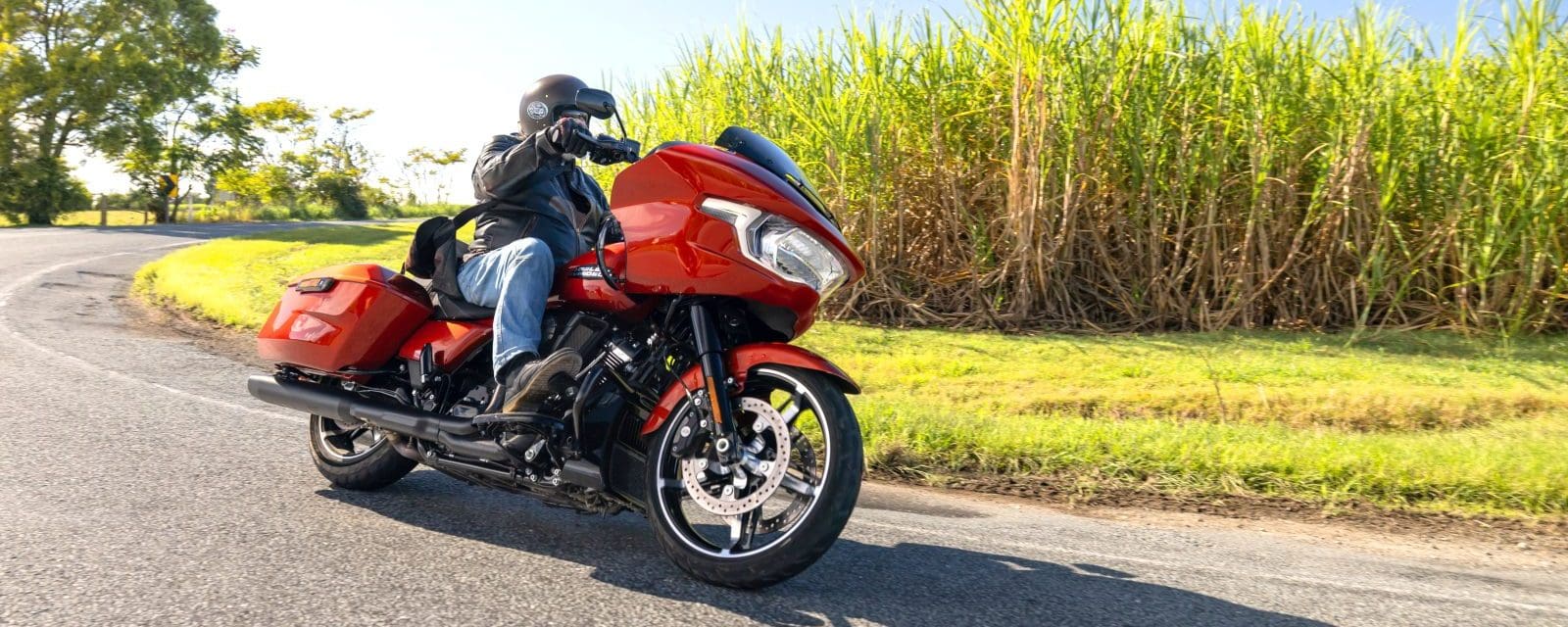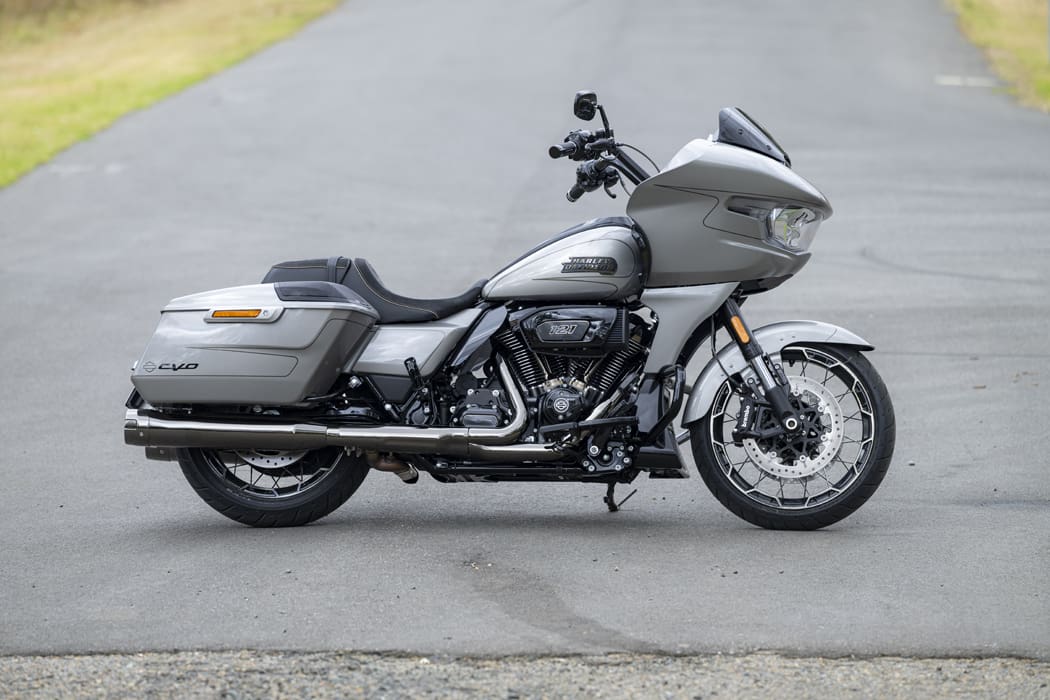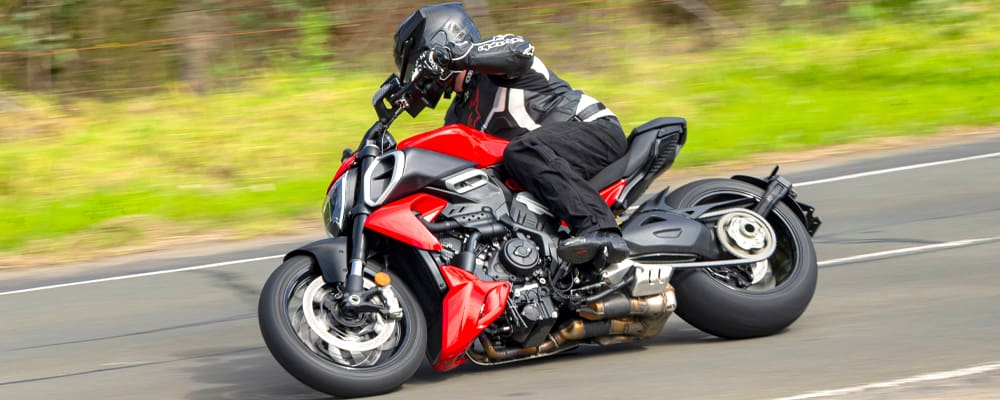Riding through Skid Row, past lines of tents erected on some of Downtown Los Angeles’ grubbier sidewalks, seemed a strange introduction to the new Royal Enfield Shotgun 650. But I shouldn’t have been surprised. Since its big push onto the global stage with a brace of new models, including the Himalayan in 2016 and the Interceptor and Continental GT 650s around a year later, Royal Enfield has always danced to the beat of its own drum. And so it was with the recent international launch of this new model.
Why LA? And why the grungy Downtown area? Royal Enfield Chief of Design Mark Wells explained it was the ideal place to experience the Shotgun 650 in a range of environments, including what turned out to be sometimes messy urban riding, a loop through a run-down industrial precinct, a multi-lane freeway experience and a blast through canyon country on some fabulous twisty roads.
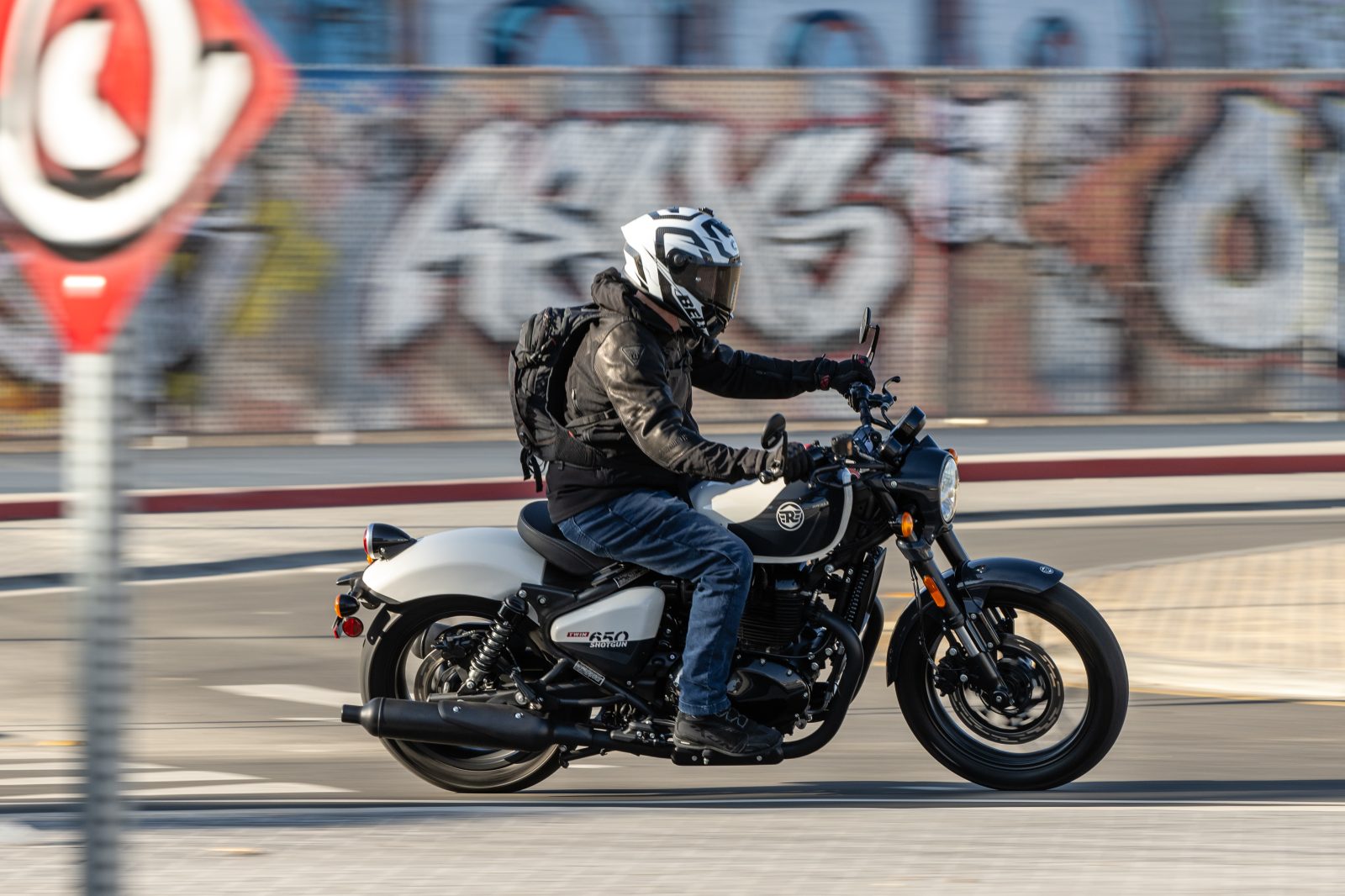
And the fact that LA has a big custom-bike-building scene played a part in the choice of launch location, with Royal Enfield describing the Shotgun 650 as a blank canvas for custom-bike builders.
In fact, Wells says Royal Enfield looked to the work of custom builders when it came to penning its design of the Shotgun 650.
“What you will see with the Shotgun is this really interesting fusion of our brand heritage, our background, our story,” he starts. “But then also bringing in the influence of customs, looking at how other people design bikes, and how people take our bikes and modify them and create new products around them… that’s now influenced what we do, and I think Shotgun for us is a really exciting product because it gives us the opportunity to do something that’s an interesting twist on what the Royal Enfield DNA is.”
The Shotgun 650 is largely based on Royal Enfield’s Super Meteor cruiser that was launched around 12 months ago. You can easily spot the familiar steel tube open-cradle frame housing the familiar air/oil cooled 648cc eight-valve parallel-twin engine used as a stressed member.
It also runs the Super Meteor’s non-adjustable Showa 43mm big-piston USD fork, and five-step preload adjustable twin rear shocks. There are, however, significant differences between the two models that go beyond a simple restyling exercise, including chassis geometry, with the Shotgun running a steeper 25.3° rake and 101.4mm trail (compared to 27.6° and 118.5mm for the Super Meteor) and a shorter wheelbase of 1465mm, down from 1500mm.
It wears an 18-inch front and 17-inch rear wheel instead of the Super Meteor’s more cruiser-like 19/16-inch combination, and has more rear suspension stroke, up to 90mm from 81mm.
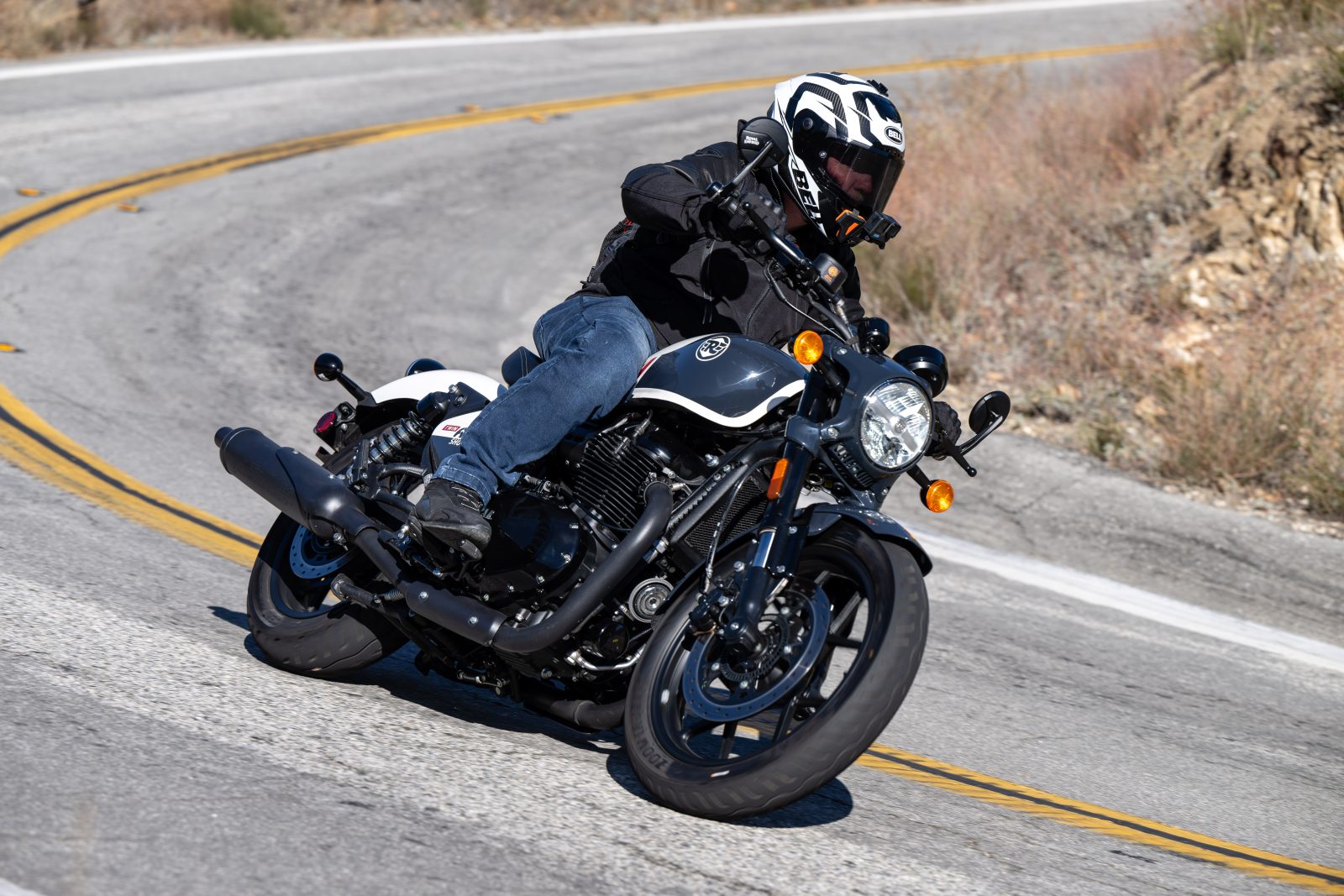
The result of the chassis changes is a sportier feel that matches the Shotgun’s more upright riding position, which sees you perched on a slightly higher 795mm seat, more hunched over the front ’bar, and with feet positioned farther back on lower, mid-bike positioned footpegs.
On the styling front, the Shotgun 650 scores the blacked-out treatment big time, with frame, fork, engine, pea-shooter exhausts, wheels, handlebar, mirrors, levers, headlight surround and more all finished in a combination of gloss and matt blacks. The Shotgun also has a reshaped and slightly smaller 13.8-litre fuel tank, and a unique floating seat that seemingly hovers over the clean rear guard. If you want to carry a pillion (or luggage) there’s an optional pillion seat that sits on a mount that in turn bolts onto the Shotgun’s frame, leaving the rear guard untouched.
While the styling of the Shotgun gives it an aggressive look, its low profile means it’s not an intimidating bike when you walk up to it.
Mark Wells says this is vitally important. When a potential customer looks at the Shotgun, Wells wants them to think: “I can manage this, I can ride this, I’m not scared by this, I’m not intimidated by this…”

At 240kg (wet) the Shotgun isn’t exactly light but, thanks to its low seat, narrow waist and wide handlebar, it’s easily manageable at low speeds. This becomes apparent when poking along in heavy morning traffic in Downtown LA. In fact, everything about the Shotgun feels manageable, from the progressive clutch engagement and the linear power delivery to the planted feeling over potted road surfaces and the adequate, rather than aggressive, feel of the braking package.
As with all twin-cylinder Royal Enfields, the engine is a highlight. Sure, peak output is a modest 34.6kW (46.4hp) of power at 7250rpm and 52.3Nm of torque at 5650rpm, but you don’t have to rev it hard to extract decent performance. The generous spread of torque throughout the rev range means you can be lazy with the six-speed gearbox. Let revs drop to just above idle and wind on the throttle in taller gears, and the Shotgun gradually picks up the pace, with the well-sorted fueling ensuring there are no hiccups or snatchiness. The other thing I like about the twin is its tasty exhaust note, which tempts you to open and close the throttle just to listen to it, especially when riding between tall buildings or through tunnels.
As well as smoking pot, lane-splitting is perfectly legal in California and, as our convoy of Shotguns worked its way east through heavy traffic on LA’s multi-lane freeways, the sweet smell of marijuana mixed with the bitter exhaust fumes ensured I kept a close eye on the behaviour of the cars and trucks around me. Thanks to the upright riding position and effective (optional) ’bar-end mirrors, spotting unpredictable traffic on the Shotgun is a breeze. A couple of times I had to brake heavily as gaps between cars and trucks quickly closed, and while not offering astounding performance, the single 320mm disc up front with its twin-piston ByBre caliper offers good feel at the span-adjustable lever, and is well aided by the rear 300mm disc.
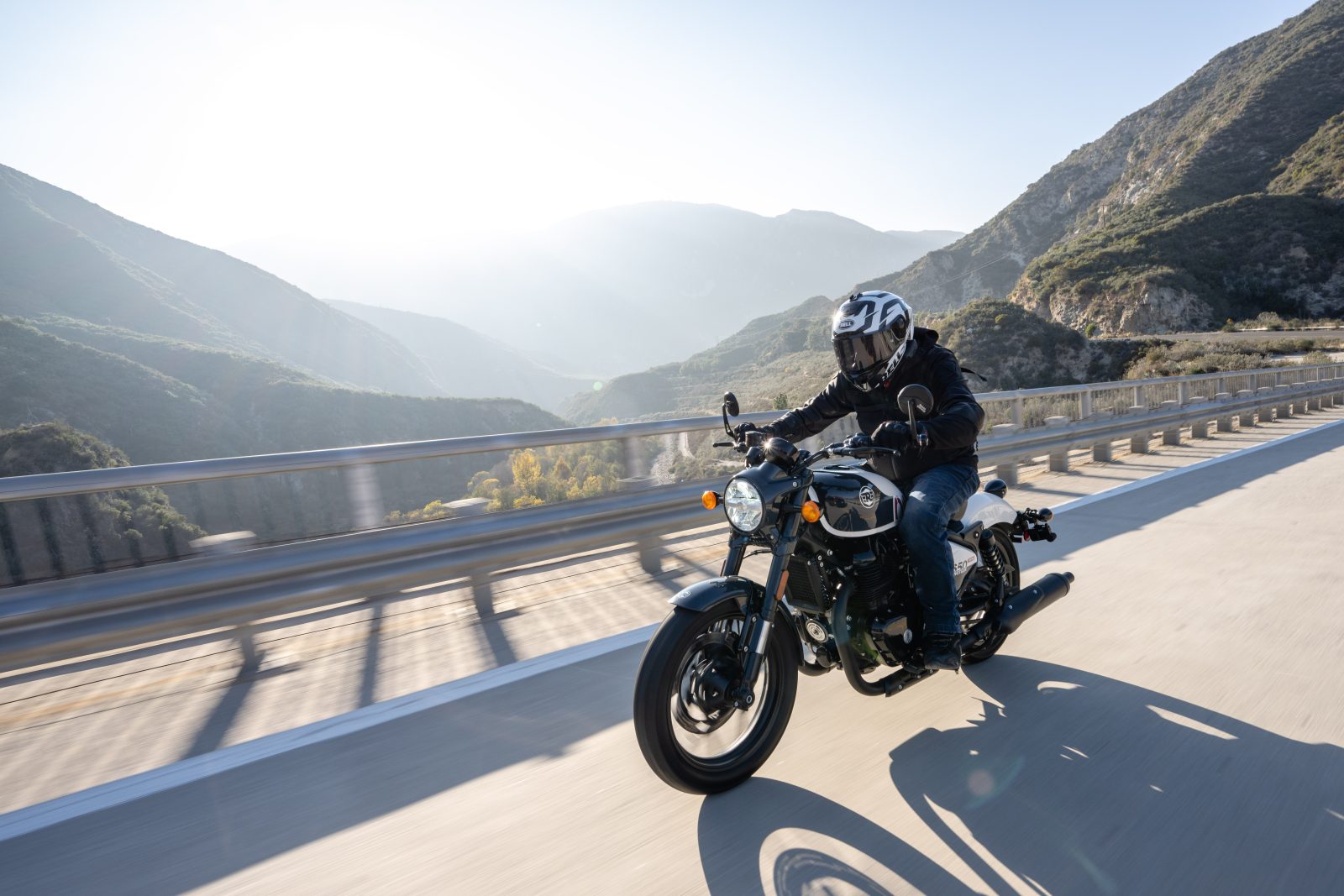
The canyon area up in the hills behind LA is a scratcher’s paradise; the winding roads are mostly smooth with a predictable surface, and there’s a combination of fast open sweepers and tight lefts and rights that have you braking hard into corners and getting on the gas as early as possible on the way out. Hardly the territory for a bobber-style bike like the Shotgun 650, right? Well, as I said earlier, Royal Enfield dances to the beat of its own drum… and, in this case, just as well.
The Shotgun 650 is an entertaining companion through the twisty stuff. The main limiting factor when cornering is a lack of ground clearance; with the ’pegs mounted farther back and lower than on the Super Meteor, you don’t have to crank it over far before the hero knobs grind away on the blacktop. Hang off the inside of the bike to keep it as upright as possible through corners, however, and you can still punt the Shotgun along at a decent clip. It feels eager to turn into corners and it holds a line well.
The CEAT rubber – a 100/90-18 up front and 150/70-17 down the back – offers decent grip and the braking performance is a match for the speeds you can achieve on the Shotgun. Sure, a twin-disc set-up at the front would be better, but the single 320mm disc does a decent job, while the rear brake is handy if you need to tighten a line mid-corner. The brakes never feel as though they are lacking.
Although non-adjustable, the Showa fork is set up in such a way that it offers a good compromise between ride quality and control. There isn’t excessive fork dive when braking hard and yet there’s enough travel and compliance to handle big bumps and potholes. Even the twin-shock rear-end, with its limited 90mm of suspension stroke, isn’t the bone-jarring experience over crook surfaces that you might expect. I had it on the lowest of the five preload settings, which seemed to suit my 78kg weight well, and it only bottomed out a couple of times on big hits.
The slightly hunched-over riding position is well suited to open-road riding, and the wind blast at highway speeds takes all the weight off your wrists. Despite the low seat height there is surprisingly good leg room thanks to the low-mounted ’pegs.
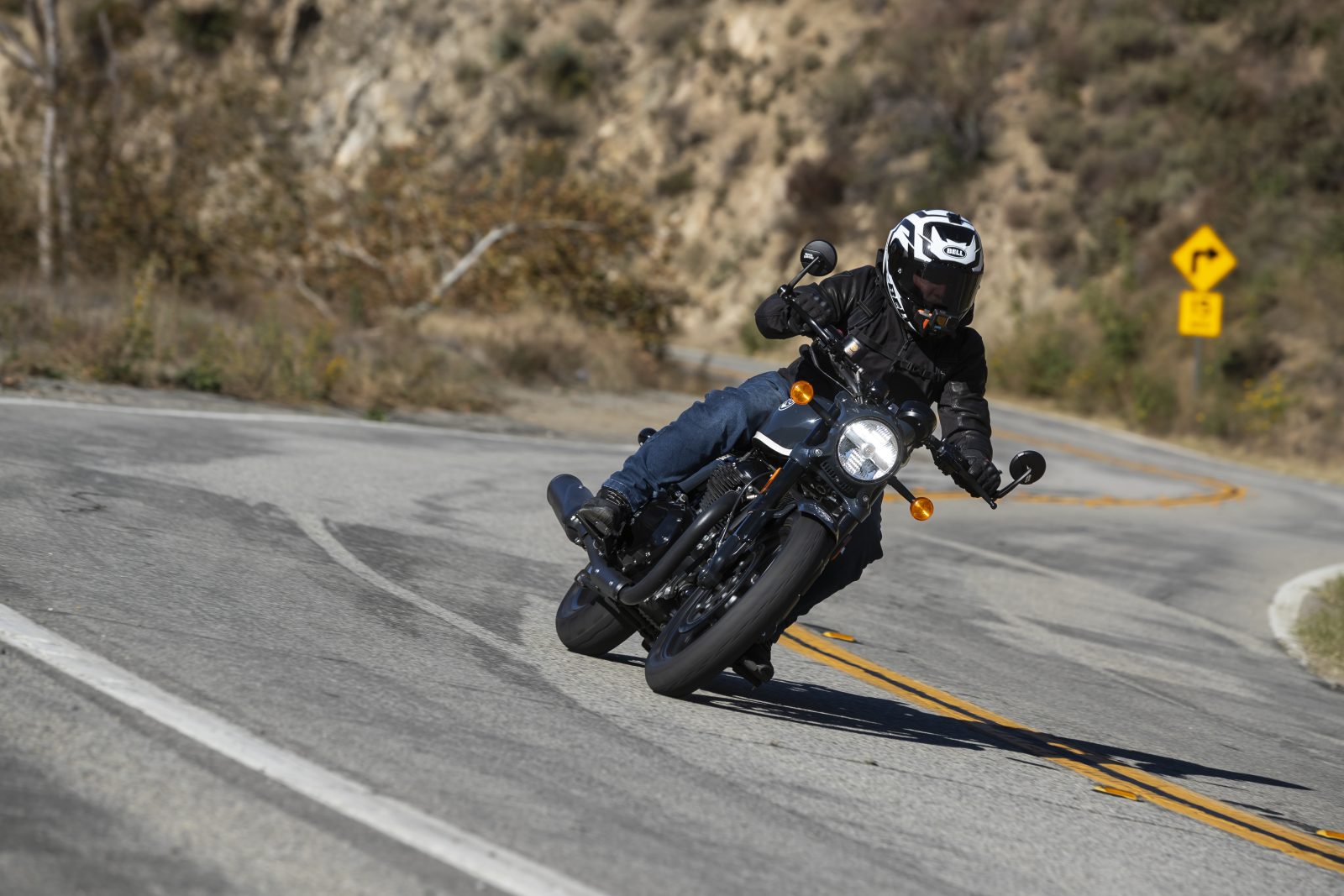
After a full day in the saddle I felt as fresh as a daisy by the time we returned to our digs as the sun dropped below the horizon. My only complaint regarding comfort is the firm seat, which had me moving around on the freeway sections to avoid that numb-bum feeling. There is an optional seat that looks as though it would offer a better level of cushioning.
Other than dual-channel ABS, there are no trick traction aids or selectable ride modes on the Shotgun 650. This simplicity is refreshing when you first jump aboard an unfamiliar bike and don’t have to spend half a day trying to figure out how everything works – just jump on and ride. For those who want turn-by-turn navigation, the Shotgun is equipped with RE’s Tripper navigation system in the right-side gauge, while the main gauge on the left provides a large analogue speedo and a small LCD display for fuel, odo, trips and clock etc. There’s also RE’s Wingman app that offers bike location, fuel and engine oil levels, service reminders and more, as well as a USB port for device charging.
Fit and finish is excellent and all those bits that are nowadays plastic on most other bikes are still made of steel on the Shotgun 650, including the tank, mudguards and even the side covers.
The Shotgun is available in four colour options – Stencil White, Plasma Blue, Green Drill and Sheetmetal Grey – each of which come with their own graphics and all of which look trick. A centrestand is standard fitment and there are more than 30 genuine accessories on offer including items such as wheels, sump guards, engine guards, lights, ’bar-end mirrors and more.
At this stage pricing details are yet to be confirmed but our guess is the Shotgun 650 will undercut the Super Meteor by a smidge and cost a bit more than an Interceptor 650. So it will probably come in at around $11,490 ride away. And Aussie distributor Urban Moto Imports (UMI) is still waiting confirmation regarding an on-sale date, but you can bet it will be soon.
UMI Marketing Manager Tom Fossati reckons the Shotgun 650 is going to be a bit of a dark horse in terms of its sales success, and after spending a day with it I reckon he’s on the money. It looks great, it’s a bag of fun to ride and there’s very little doubt it will be priced attractively. But perhaps its most valubale asset is that it will appeal to those who want to ride it as is, throw a handful of accessories at it or customise the hell out of it.
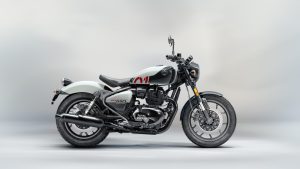


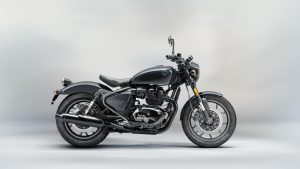
SPECIFICATIONS
Engine
Capacity 648cc
Type Parallel-twin, SOHC, four valves per cylinder
Bore & stroke 78mm x 67.8mm
Compression ratio 9.5:1
Cooling Air/oil
Fueling EFI, with dual throttle bodies
Transmission Six-speed
Clutch Wet, multi-plate, slip-assist
Final drive Chain
PERFORMANCE
Power 34.6kW (46.3hp) @ 7250rpm (claimed)
Torque 52.3Nm @ 5650rpm (claimed)
Top speed 175km/h (est)
Fuel consumption Not measured
ELECTRONICS
Type Bosch
Rider aids ABS
Rider modes Not applicable
CHASSIS
Frame material Composite steel
Frame type Open-cradle duplex spine
Rake 25.3°
Trail 101.4mm
Wheelbase 1465mm
SUSPENSION
Type Showa
Front: 43mm Big Piston fork, non-adjustable, 120mm travel
Rear: Twin shocks, five-step preload adjustable, 90mm shock travel
WHEELS & BRAKES
Wheels Forged aluminium
Front: 18 x 2.5 Rear: 17 x 4.5
Tyres CEAT Zoom Cruz
Front: 100/90-18 (56H)
Rear: 150/70-17 (69H)
Brakes ByBre, ABS
Front: Single 320mm disc,
twin-piston caliper
Rear: Single 300mm disc,
twin-piston caliper
DIMENSIONS
Weight 240kg (with 90% fuel, claimed)
Seat height 795mm
Width 820mm
Height 1105mm
Length 2170mm
Ground clearance 140mm
Fuel capacity 13.8L
SERVICING & WARRANTY
Servicing First: 1000km
Minor: 5000km
Major: 10,000km
Warranty Three years,
unlimited kilometres
BUSINESS END
Price TBC
Colour options Stencil White, Plasma Blue, Green Drill and Sheetmetal Grey
CONTACT
royalenfield.com.au

